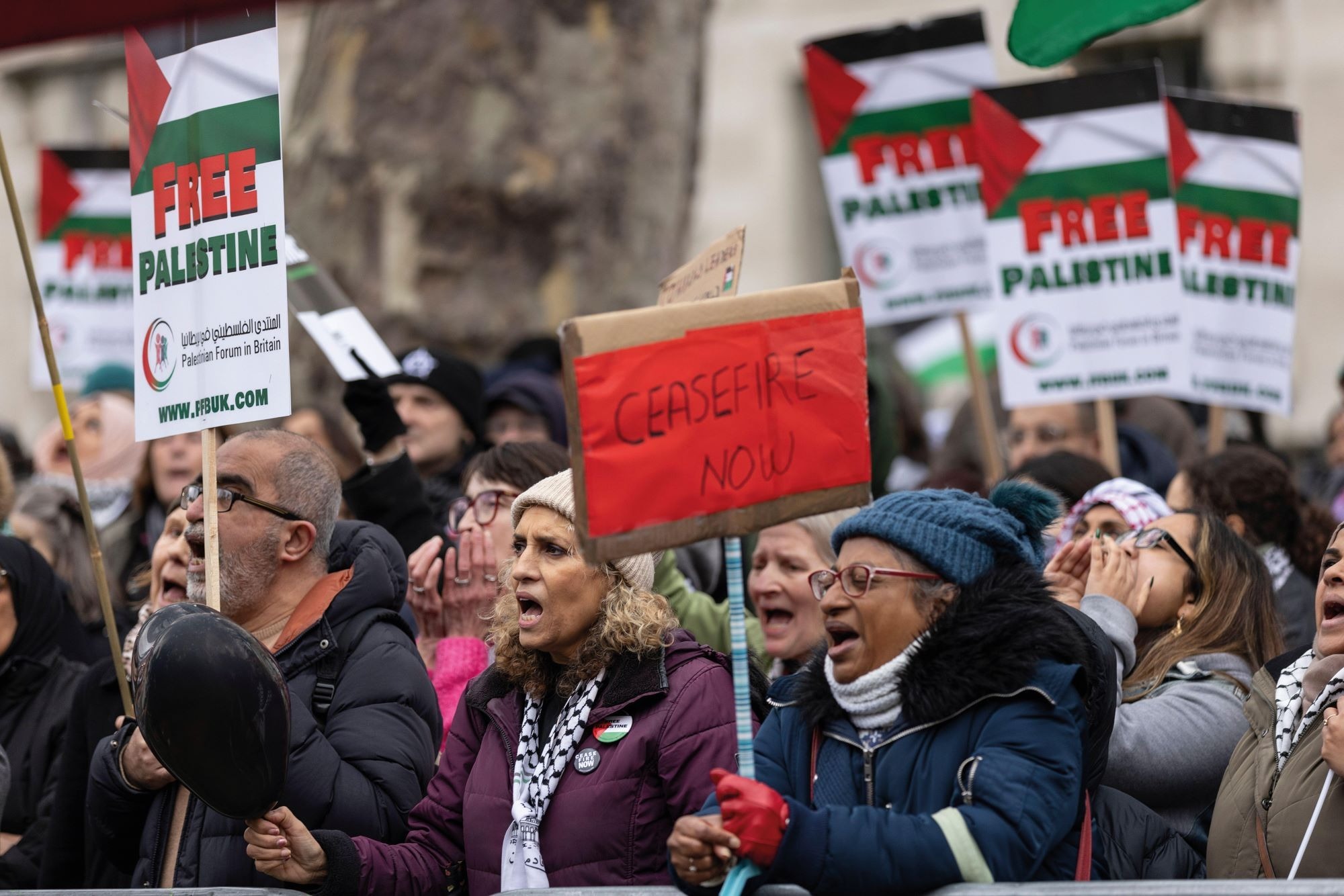
Many of us are still reeling from Trump’s decisive election victory. One of the most difficult aspects to come to terms with is how this most divisive and bigoted of men managed to create a kind of “rainbow coalition”. Not only did he bring together Christian nationalists and libertarian tech oligarchs, Trump won a majority of the Hispanic male vote and even managed to pull in one in three of the black vote. Apparently, both racists and their victims found a place under the umbrella of the new president.
Whereas the Republicans managed to build and sustain a diverse coalition, it was evident throughout Kamala Harris’s campaign that the Democrats were finding it much more difficult to bring together those groups that, on paper, would seem to have a common interest in opposing Trumpian racism. While it wasn’t the only factor that put the voting bloc under strain, irreconcilable differences over Israel and antisemitism were the most visible sign that something had broken. While the traditional Jewish Democratic majority stayed together (about 80 per cent of Jewish voters supported Harris), others who opposed Harris’s perceived support for the war in Gaza found the prospect of voting for her a bitter pill to swallow. For example, much of the Arab-American population in Dearborn, Michigan (the only Arab majority city in the US) voted for Trump or third-party candidates in disgust at Harris.
It’s been evident for some time that coalition-building across the “progressive” liberal-left spectrum has become more and more difficult to achieve. Some of that difficulty concerns the flood of information we are subjected to in the online age. It’s harder now to ignore differences with one’s potential allies, particularly when it comes to hot-button issues such as Israel-Palestine and gender politics. At stake here are questions of solidarity, a term much used in progressive politics. Do we need a “strong” kind of solidarity based on empathy and friendship within a movement founded on shared values? Or is it better to rely on a “weaker” or more fluid version of solidarity – the concept as it is traditionally understood – in which diverse groups work together towards a set of specific goals?
British journalist Rachel Shabi implicitly leans towards a stronger solidarity, rooted in shared understanding. Her new book Off White: The Truth About Antisemitism explores how differences over antisemitism and Israel are fracturing anti-racist solidarity.
She is right to identify the issue as a key source of division. The UK, like the US, has seen its own conflicts on the left over such issues, most notoriously during 2015-2020, when Jeremy Corbyn led the Labour Party. Shabi was one of the few voices on the left who both supported the attempt to swing the party leftwards and acknowledged that there was something to the accusations of antisemitism beyond bad-faith attempts to destroy the leader.
In Off White, Shabi has no illusions as to the scale of the task ahead. She refers to the subject of antisemitism on the left as “a horrible, divisive battleground, an ugly, distorted mess of claims and counterclaims”, one that has torn progressive movements apart. “What we have been struggling with is a jumble of contradictory, but separate and identifiable problems: a comprehension gap in understanding antisemitism as a live structure of racism; divisions over the way claims of antisemitism get deployed in our politics; confusions caused by the way we understand Israel, or the way different elements of the far right use both Israel and antisemitism.” This comprehension gap can breed an attitude of complacency – the sense that it is yesterday’s issue or one confined to neo-Nazis. More generally, Shabi points out, antisemitism doesn’t seem to fit the story of racism today as it is often told on the left: of persistent structural disadvantage and bigotries premised on skin colour.
Off White goes on to argue that an understanding of antisemitism actually serves to enrich our understanding of racism. Shabi is certainly the right person to pen such a book. Her own background situates her on the faultlines of anti-racist understanding. Her Iraqi-Jewish origins are far from the Ashkenazi (German/Eastern European) Jewish stereotype. At the same time, as she acknowledges, her skin colour and appearance mean she can “pass” as white. While she also shows how Ashkenazi Jews often resist whiteness and the assumed white privilege, telling the story of the Jews of the Middle East can help to disturb simplistic views of Jews and of Israelis.
For Shabi, the story of Jews in the Arab world was a largely positive one and it is certainly true that Jewish populations had, on the whole, a much less torrid time of it than Jews in Christian Europe did. Still, there were also periods of persecution, and the position of Jews in Muslim lands was ultimately predicated on a structured hierarchy that was a long way from equality. In any case, it all fell apart in the end. From 1948, the year of Israeli independence, a process of expulsion, riots and official pressure to leave led most Jews to quit Arab countries for good, many flocking to Israel.
A particular understanding of this process is crucial to Shabi’s argument. For her, the turmoil that followed the foundation of the state of Israel was the result of a wider process of imperialist racism that divided and ruled the Middle East, destroying any possibility of diverse co-existence. At the same time, the deep history of European antisemitism and its expression in the Holocaust led to the Ashkenazi Zionist settlement of Israel. Here then, is where the histories of racism and antisemitism meet.
In telling this story, Shabi uses the term “Arab-Jews” to describe her ancestors. This is an identity that many Jews of her background would fiercely resist, instead telling a bitter story of Arab-Jewish relations, one of separate lives and discrimination.
Shabi does not avoid these awkward realities. As a critic of Zionism she is unusually empathetic to the motivations of Jews who settled Israel and continue to live there and does not dismiss the attachments that diaspora Jews have to the state (she herself has family there). She also calls out the use of antisemitic tropes within pro-Palestinian solidarity activism. Off White calls for leftists to go the extra mile in embracing these complex histories and entangled narratives with honesty and courage.
Yet implicit in the book is a kind of faith that the crooked anti-racist timber can somehow be straightened. That leads Shabi to avoid some difficult issues even as she tackles others. She doesn’t really engage with Muslim antisemitism as a specific tradition. And however much she takes antisemitism on the left seriously, she also reassures her readers that the most virulent form of Jew-hatred continues to be on the right (which may be correct in some contexts, but is hard to evidence as a general truth).
There is much riding on reckoning with the tangled histories of antisemitism and racism. On the left, an awful lot of hope has been invested in the power of solidarity to bind together movements that will change the world. The enormous growth of pro-Palestinian solidarity movements since 7 October 2023 is a source of inspiration to many radicals. Alongside Shabi’s book, 2024 also saw the publication of Rebecca Vilkomerson and Alissa Wise’s Solidarity Is the Political Version of Love and Shane Burley and Ben Lorber’s Safety Through Solidarity – both of them books by American Jews involved in Palestine activism. While neither book denies that solidarity-based activism can be difficult, both of them demonstrate an ultimate faith that earnest struggle in a spirit of goodwill can lead us to join arms with each other against the “real enemy”.
Yet even if a harmonious spirit of understanding can be built within progressive social movements, what is the place of those who are not activists? There are many Jews who are horrified at Netanyahu and the excesses of the Gaza war, but are also wary of the agenda and the rhetoric of some within the pro-Palestinian movement. Much can be lost when potential allies are alienated. It’s becoming increasingly clear that opposing the discrimination, authoritarianism and sheer cruelty of the ascendant global right exemplified by Trump, Netanyahu, Orbán, Putin et al is going to require a monumental collective effort. Not only are broad coalitions going to need to be formed across ideological lines, everyday life itself also needs to be a front in this struggle. Anti-racism can be a matter of how we treat others in everyday life, how we quietly resist attempts to turn people against each other.
If such efforts are to succeed, it may be that accepting, rather than seeking to solve, the contradictions and tensions within anti-racist activism is the right way to go. The Trumpian coalition is bound together by a potent cocktail of self-interest, cynicism, delusion, lies and hate. Progressive resistance does not need to be this toxic, but it’s essential to recognise the limits of solidarity as a binding force.Perhaps the efforts that Shabi and others have made to reconcile different tensions in progressive movements are not as necessary as they think. Perhaps a grim cynicism that would tolerate strange bedfellows (at least temporarily) is a better way forward. Solidarity can be powerful, as Off White explores. But if it’s what we need right now, it needs to be the “weakest” version possible.
“Off White: The Truth About Antisemitism” by Rachel Shabi is published by Oneworld.
This article is from New Humanist’s Spring 2025 issue. Subscribe now.

